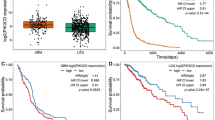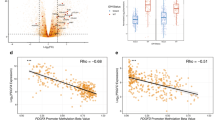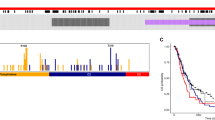Abstract
Loss-of-function mutations in the phosphatase PTEN (phosphatase and tensin homolog deleted on chromosome10) contribute to aberrant cell growth in part through upregulation of the mitogenic IGF-1/PI3K/Akt pathway. In turn, this pathway exerts a homeostatic feedback over PTEN. Using mutagenesis analysis to explore a possible impact of this mutual control on astrocyte growth, we found that truncation of the C-terminal region of PTEN (Δ51) associates with a marked increase in NFκB activity, a transcription factor overactivated in astrocyte tumors. Whereas mutations of PTEN are considered to lead to a loss-of-function, PTENΔ51, a truncation that comprises a region frequently mutated in human gliomas, displayed a neomorphic (gain-of-function) activity that was independent of its phosphatase activity. This gain-of-function of PTENΔ51 includes stimulation of IGF-1 synthesis through protein kinase A activation of the IGF-1 promoter. Increased IGF-1 originates an autocrine loop that activates Akt and NFκB. Constitutive activation of NFκB in PTENΔ51-expressing astrocytes leads to aberrant cell growth; astrocytes expressing this mutant PTEN generate colonies in vitro and tumors in vivo. Mutations converting a tumor suppressor such as PTEN into a tumor promoter through a gain-of-function involving IGF-1 production may further our understanding of the role played by this growth factor in glioma growth and help us define druggable targets for personalized therapy.
This is a preview of subscription content, access via your institution
Access options
Subscribe to this journal
Receive 50 print issues and online access
$259.00 per year
only $5.18 per issue
Buy this article
- Purchase on Springer Link
- Instant access to full article PDF
Prices may be subject to local taxes which are calculated during checkout






Similar content being viewed by others
References
Parsons DW, Jones S, Zhang X, Lin JC, Leary RJ, Angenendt P et al. An integrated genomic analysis of human glioblastoma multiforme. Science 2008; 321: 1807–1812.
Louis DN, Ohgaki H, Wiestler OD, Cavenee WK, Burger PC, Jouvet A et al. The 2007 WHO classification of tumours of the central nervous system. Acta Neuropathol 2007; 114: 97–109.
Carnero A, Blanco-Aparicio C, Renner O, Link W, Leal JF . The PTEN/PI3K/AKT signalling pathway in cancer, therapeutic implications. Curr Cancer Drug Targets 2008; 8: 187–198.
Werner H, Bruchim I . The insulin-like growth factor-I receptor as an oncogene. Arch Physiol Biochem 2009; 115: 58–71.
Antoniades HN, Galanopoulos T, Neville-Golden J, Maxwell M . Expression of insulin-like growth factors I and II and their receptor mRNAs in primary human astrocytomas and meningiomas; in vivo studies using in situ hybridization and immunocytochemistry. Int J Cancer 1992; 50: 215–222.
Sandberg AC, Engberg C, Lake M, von HH, Sara VR . The expression of insulin-like growth factor I and insulin-like growth factor II genes in the human fetal and adult brain and in glioma. Neurosci Lett 1988; 93: 114–119.
Pons S, Torres-Aleman I . Insulin-like growth factor-i stimulates dephosphorylation of ikappa b through the serine phosphatase calcineurin (Protein Phosphatase 2B). J Biol Chem 2000; 275: 38620–38625.
Fernandez S, Garcia-Garcia M, Torres-Aleman I . Modulation by insulin-like growth factor I of the phosphatase PTEN in astrocytes. Biochim Biophys Acta 2008; 1783: 803–812.
Feinman R, Koury J, Thames M, Barlogie B, Epstein J, Siegel DS . Role of NF-kappaB in the rescue of multiple myeloma cells from glucocorticoid-induced apoptosis by bcl-2. Blood 1999; 93: 3044–3052.
Chen J, McKay RR, Parada L . Malignant Glioma: Lessons from Genomics, Mouse Models, and Stem Cells. Cell 2012; 149: 36–47.
Karin M . Nuclear factor-[kappa]B in cancer development and progression. Nature 2006; 441: 431–436.
Perkins ND . Integrating cell-signalling pathways with NF-[kappa]B and IKK function. Nat Rev Mol Cell Biol 2007; 8: 49–62.
Bredel M, Scholtens DM, Yadav AK, Alvarez AA, Renfrow JJ, Chandler JP et al. NFKBIA deletion in glioblastomas. N Engl J Med 2011; 364: 627–637.
Gustin JA, Maehama T, Dixon JE, Donner DB . The PTEN tumor suppressor protein inhibits tumor necrosis factor-induced nuclear factor kappa B activity. J Biol Chem 2001; 276: 27740–27744.
Vasudevan KM, Gurumurthy S, Rangnekar VM . Suppression of PTEN expression by NF-kappa B prevents apoptosis. Mol Cell Biol 2004; 24: 1007–1021.
Shono T, Tofilon PJ, Bruner JM, Owolabi O, Lang FF . Cyclooxygenase-2 expression in human gliomas: prognostic significance and molecular correlations. Cancer Res 2001; 61: 4375–4381.
Engelman JA, Luo J, Cantley LC . The evolution of phosphatidylinositol 3-kinases as regulators of growth and metabolism. Nat Rev Genet 2006; 7: 606–619.
Shen WH, Balajee AS, Wang J, Wu H, Eng C, Pandolfi PP et al. Essential role for nuclear PTEN in maintaining chromosomal integrity. Cell 2007; 128: 157–170.
Forbes SA, Bhamra G, Bamford S, Dawson E, Kok C, Clements J et al. The catalogue of somatic mutations in cancer (COSMIC). Curr Protoc Hum Genet 2008; 39: D945–D950.
Forbes SA, Bindal N, Bamford S, Cole C, Kok CY, Beare D et al. COSMIC: mining complete cancer genomes in the catalogue of somatic mutations in cancer. Nucleic Acids Res 2011; 39: D945–D950.
Rahdar M, Inoue T, Meyer T, Zhang J, Vazquez F, Devreotes PN . A phosphorylation-dependent intramolecular interaction regulates the membrane association and activity of the tumor suppressor PTEN. Proc Natl Acad Sci USA 2009; 106: 480–485.
Taniguchi CM, Tran TT, Kondo T, Luo J, Ueki K, Cantley LC et al. Phosphoinositide 3-kinase regulatory subunit p85alpha suppresses insulin action via positive regulation of PTEN. Proc Natl Acad Sci USA 2006; 103: 12093–12097.
Kachra Z, Yang CR, Murphy LJ, Posner BI . The regulation of insulin-like growth factor-binding protein 1 messenger ribonucleic acid in cultured rat hepatocytes: the roles of glucagon and growth hormone. Endocrinology 1994; 135: 1722–1728.
McCarthy TL, Thomas MJ, Centrella M, Rotwein P . Regulation of insulin-like growth factor I transcription by cyclic adenosine 3',5'-monophosphate (cAMP) in fetal rat bone cells through an element within exon 1: protein kinase A-dependent control without a consensus AMP response element. Endocrinology 1995; 136: 3901–3908.
Thomas MJ, Umayahara Y, Shu H, Centrella M, Rotwein P, McCarthy TL . Identification of the cAMP response element that controls transcriptional activation of the insulin-like growth factor-I gene by prostaglandin E2 in osteoblasts. J Biol Chem 1996; 271: 21835–21841.
Vousden KH, Lane DP . p53 in health and disease. Nat Rev Mol Cell Biol 2007; 8: 275–283.
Bartkova J, Hamerlik P, Stockhausen MT, Ehrmann J, Hlobilkova A, Laursen H et al. Replication stress and oxidative damage contribute to aberrant constitutive activation of DNA damage signalling in human gliomas. Oncogene 2010; 29: 5095–5102.
Takahashi K, Suzuki K . Association of insulin-like growth-factor-I-induced DNA synthesis with phosphorylation and nuclear exclusion of p53 in human breast cancer MCF-7 cells. Int J Cancer 1993; 55: 453–458.
Johnson ReF Perkins ND . Nuclear factor-+¦B, p53, and mitochondria: regulation of cellular metabolism and the Warburg effect. Trends Biochem Sci 2012; 37: 317–324.
Nowsheen S, Wukovich RL, Aziz K, Kalogerinis PT, Richardson CC, Panayiotidis MI et al. Accumulation of oxidatively induced clustered DNA lesions in human tumor tissues. Mutat Res 2009; 674: 131–136.
Maillet A, Pervaiz S . Redox regulation of p53, redox effectors regulated by p53: a subtle balance. Antioxid Redox Signal 2012; 16: 1285–1294.
Bartkova J, Horejsi Z, Koed K, Kramer A, Tort F, Zieger K et al. DNA damage response as a candidate anti-cancer barrier in early human tumorigenesis. Nature 2005; 434: 864–870.
Jenkins LM, Durell SR, Mazur SJ, Appella E . p53 N-terminal phosphorylation: a defining layer of complex regulation. Carcinogenesis 2012; 33: 1441–1449.
Jacques TS, Swales A, Brzozowski MJ, Henriquez NV, Linehan JM, Mirzadeh Z et al. Combinations of genetic mutations in the adult neural stem cell compartment determine brain tumour phenotypes. EMBO J 2010; 29: 222–235.
Green A, Beer P . Somatic mutations of IDH1 and IDH2 in the leukemic transformation of myeloproliferative neoplasms. N Engl J Med 2010; 362: 369–370.
Chalhoub N, Baker SJ . PTEN and the PI3-kinase pathway in cancer. Annu Rev Pathol 2009; 4: 127–150.
Maier D, Jones G, Li X, Schonthal AH, Gratzl O, Van Meir EG et al. The PTEN lipid phosphatase domain is not required to inhibit invasion of glioma cells. Cancer Res 1999; 59: 5479–5482.
Tang Y, Eng C . PTEN autoregulates its expression by stabilization of p53 in a phosphatase-independent manner. Cancer Res 2006; 66: 736–742.
Li Z, Dong X, Wang Z, Liu W, Deng N, Ding Y et al. Regulation of PTEN by Rho small GTPases. Nat Cell Biol 2005; 7: 399–404.
Li J, Yen C, Liaw D, Podsypanina K, Bose S, Wang SI et al. PTEN, a putative protein tyrosine phosphatase gene mutated in human brain, breast, and prostate cancer. Science 1997; 275: 1943–1947.
Rasheed BK, Stenzel TT, McLendon RE, Parsons R, Friedman AH, Friedman HS et al. PTEN gene mutations are seen in high-grade but not in low-grade gliomas. Cancer Res 1997; 57: 4187–4190.
Duerr EM, Rollbrocker B, Hayashi Y, Peters N, Meyer-Puttlitz B, Louis DN et al. PTEN mutations in gliomas and glioneuronal tumors. Oncogene 1998; 16: 2259–2264.
Vazquez F, Ramaswamy S, Nakamura N, Sellers WR . Phosphorylation of the PTEN tail regulates protein stability and function. Mol Cell Biol 2000; 20: 5010–5018.
Vazquez F, Grossman SR, Takahashi Y, Rokas MV, Nakamura N, Sellers WR . Phosphorylation of the PTEN tail acts as an inhibitory switch by preventing its recruitment into a protein complex. J Biol Chem 2001; 276: 48627–48630.
Chen TC, Hinton DR, Zidovetzki R, Hofman FM . Up-regulation of the cAMP/PKA pathway inhibits proliferation, induces differentiation, and leads to apoptosis in malignant gliomas. Lab Invest 1998; 78: 165–174.
Wang Y, Ande SR, Mishra S . Phosphorylation of transglutaminase 2 (TG2) at serine-216 has a role in TG2 mediated activation of nuclear factor-kappa B and in the downregulation of PTEN. BMC Cancer 2012; 12: 277.
Glick RP, Lichtor T, Unterman TG . Insulin-like growth factors in central nervous system tumors. J Neurooncol 1997; 35: 315–325.
Zumkeller W, Westphal M . The IGF/IGFBP system in CNS malignancy. Mol Pathol 2001; 54: 227–229.
Baserga R . The insulin-like growth factor I receptor: a key to tumor growth? Cancer Res 1995; 55: 249–252.
Romashkova JA, Makarov SS . NF-kappaB is a target of AKT in anti-apoptotic PDGF signalling. Nature 1999; 401: 86–90.
Franco C, Fernandez S, Torres A . I. Frataxin deficiency unveils cell-context dependent actions of insulin-like growth factor I on neurons. Mol Neurodegener 2012; 7: 51.
Fernandez AM, Fernandez S, Carrero P, Garcia-Garcia M, Torres-Aleman I . Calcineurin in reactive astrocytes plays a key role in the interplay between proinflammatory and anti-inflammatory signals. J Neurosci 2007; 27: 8745–8756.
Acknowledgements
We are thankful to L. Guinea and M. Garcia for excellent technical support. This work was funded by Spanish Ministry of Science (SAF2007–60051 andSAF2010–17036) and by CIBERNED.
Author information
Authors and Affiliations
Corresponding author
Ethics declarations
Competing interests
The authors declare no conflict of interest.
Additional information
Supplementary Information accompanies this paper on the Oncogene website
Supplementary information
Rights and permissions
About this article
Cite this article
Fernández, S., Genis, L. & Torres-Alemán, I. A phosphatase-independent gain-of-function mutation in PTEN triggers aberrant cell growth in astrocytes through an autocrine IGF-1 loop. Oncogene 33, 4114–4122 (2014). https://doi.org/10.1038/onc.2013.376
Received:
Revised:
Accepted:
Published:
Issue Date:
DOI: https://doi.org/10.1038/onc.2013.376
Keywords
This article is cited by
-
PTEN proteoforms in biology and disease
Cellular and Molecular Life Sciences (2017)



